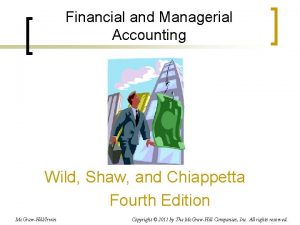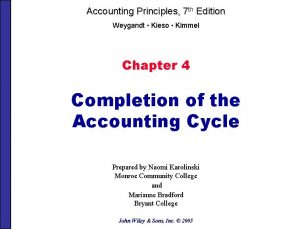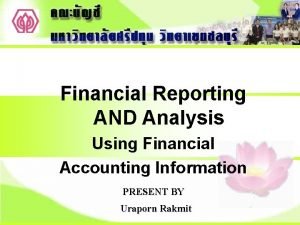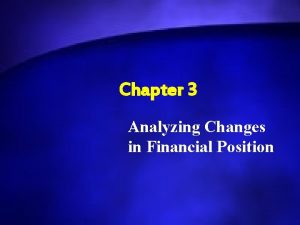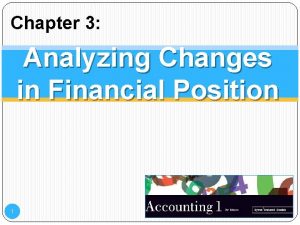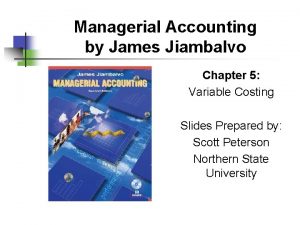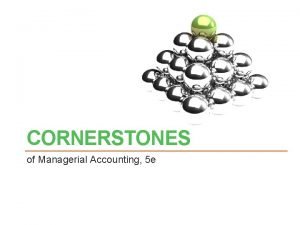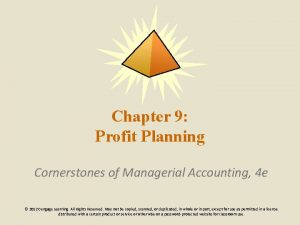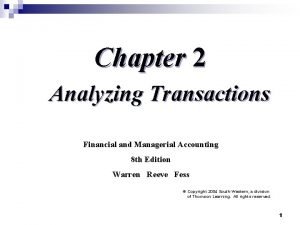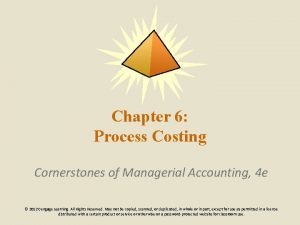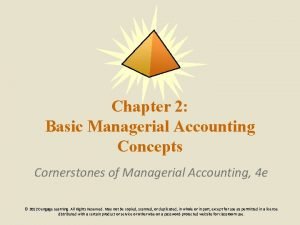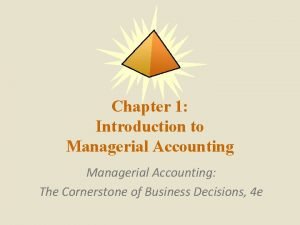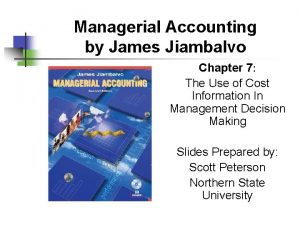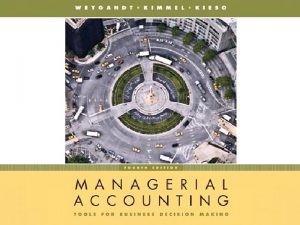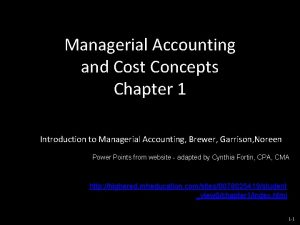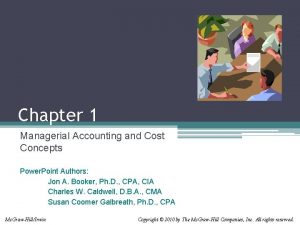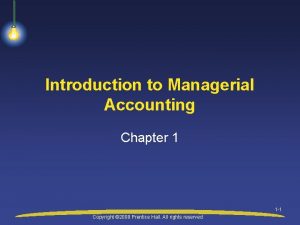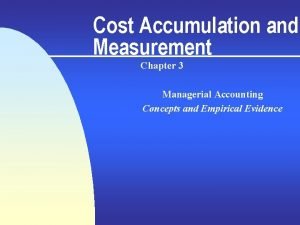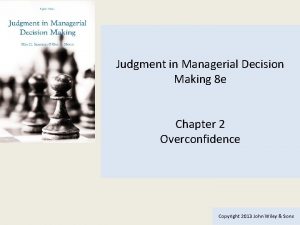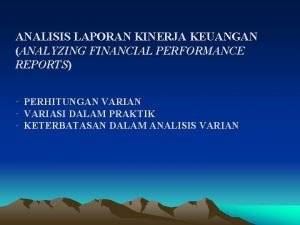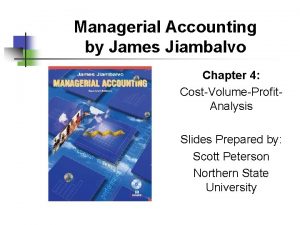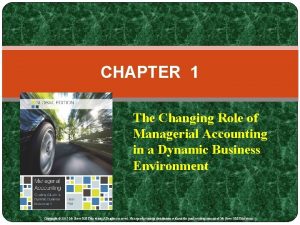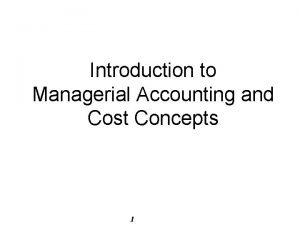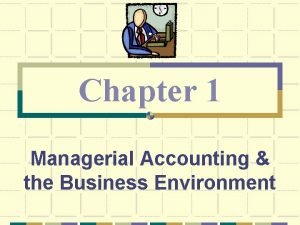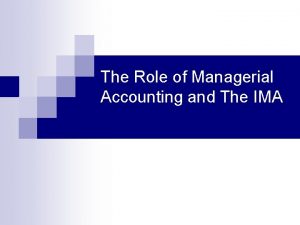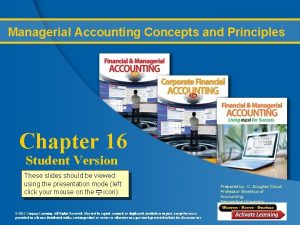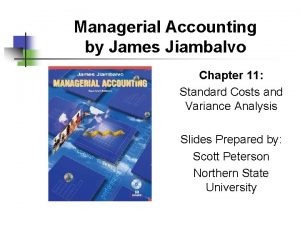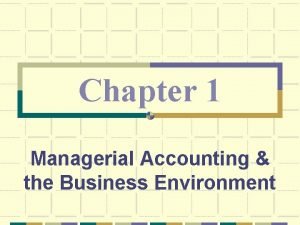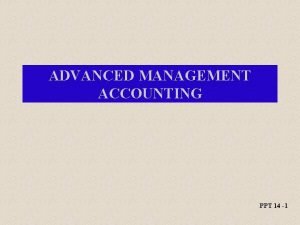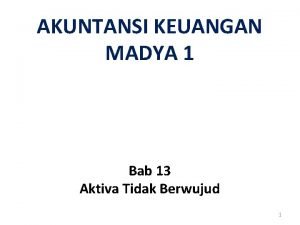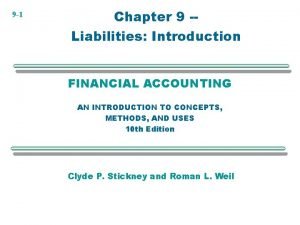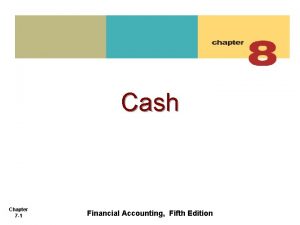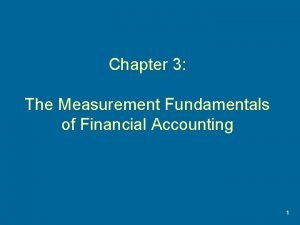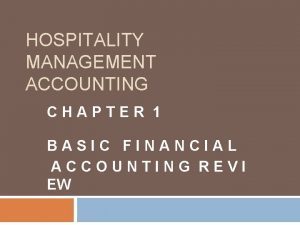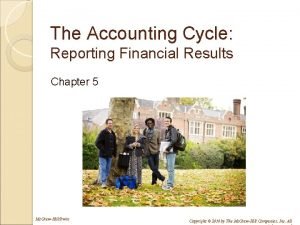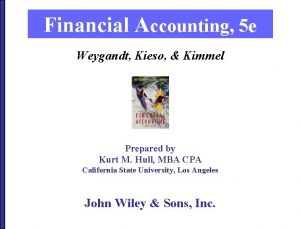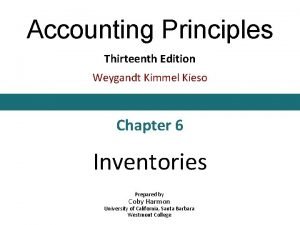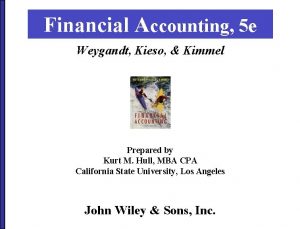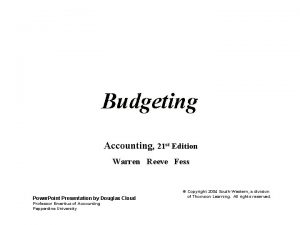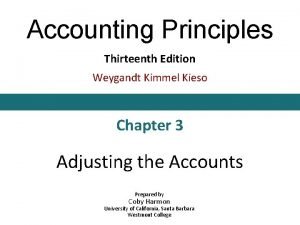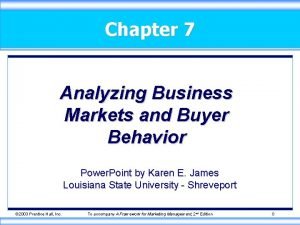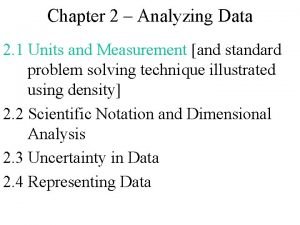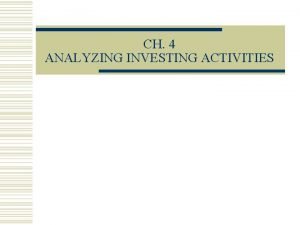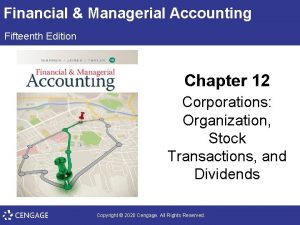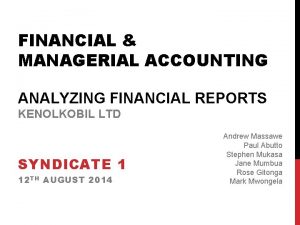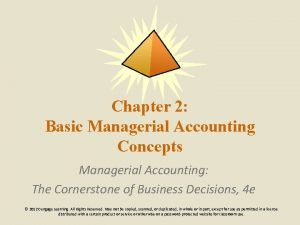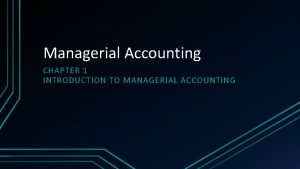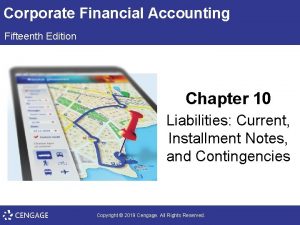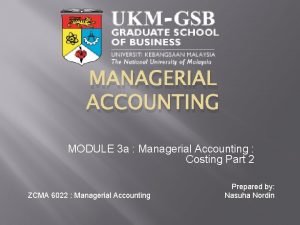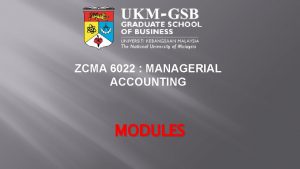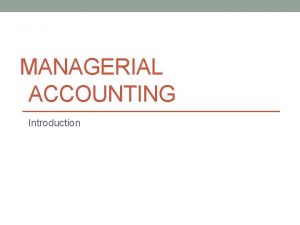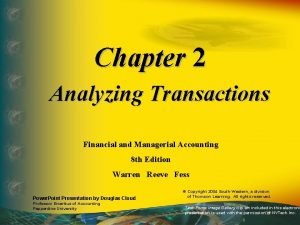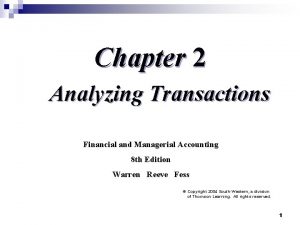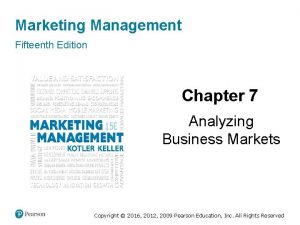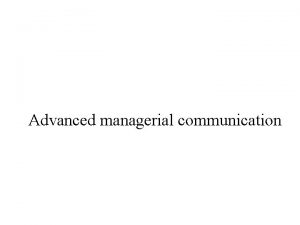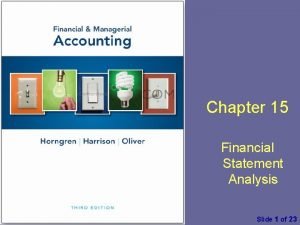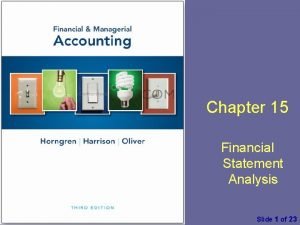Financial Managerial Accounting Fifteenth Edition Chapter 2 Analyzing


















































































- Slides: 82

Financial & Managerial Accounting Fifteenth Edition Chapter 2 Analyzing Transactions Copyright © 2020 Cengage. All Rights Reserved.

Learning Objectives • • • Obj. 1: Describe the characteristics of an account and a chart of accounts. Obj. 2: Describe and illustrate journalizing transactions using the double-entry accounting system. Obj. 3: Describe and illustrate the journalizing and posting of transactions to accounts. Obj. 4: Prepare an unadjusted trial balance and explain how it can be used to discover errors. Obj. 5: Describe and illustrate the use of horizontal analysis in evaluating a company’s performance and financial condition. Copyright © 2020 Cengage. All Rights Reserved.

Using Accounts to Record Transactions • Accounting systems are designed to show the increases and decreases in each accounting equation element as a separate record. – This record is called an account. Copyright © 2020 Cengage. All Rights Reserved.

Net. Solutions’ November Transactions Copyright © 2020 Cengage. All Rights Reserved.

The T Account (1 of 4) Copyright © 2020 Cengage. All Rights Reserved.

The T Account (2 of 4) Copyright © 2020 Cengage. All Rights Reserved.

The T Account (3 of 4) Copyright © 2020 Cengage. All Rights Reserved.

The T Account (4 of 4) Copyright © 2020 Cengage. All Rights Reserved.

Chart of Accounts • • • A group of accounts for a business entity is called a ledger. A list of the accounts in the ledger is called a chart of accounts. The accounts are normally listed in the order in which they appear in the financial statements. – The balance sheet accounts are listed first, in the order of assets, liabilities, and stockholders’ equity. – The income statement accounts are then listed in the order of revenues and expenses. Copyright © 2020 Cengage. All Rights Reserved.

Assets • Assets are resources owned by the business entity. – Examples of assets include: § § § § Cash Supplies Intangible assets (patent rights, copyrights, trademarks) Accounts receivable Prepaid expenses Buildings Equipment Copyright © 2020 Cengage. All Rights Reserved.

Liabilities • Liabilities are debts owed to outsiders (creditors). – Examples of liabilities include: § § Accounts payable Notes payable Wages payable Unearned revenues (cash received from customers before services are delivered) Copyright © 2020 Cengage. All Rights Reserved.

Stockholders’ Equity • • • Stockholders’ equity is the stockholders’ right to the assets of the business. Stockholders’ equity is represented by the balance of the common stock and retained earnings accounts. A dividends account represents distributions of earnings to stockholders. Copyright © 2020 Cengage. All Rights Reserved.

Revenues • Revenues are increases in assets and stockholders’ equity as a result of selling services or products to customers. – Examples of revenues include: § § Fees earned Fares earned Commissions revenue Rent revenue Copyright © 2020 Cengage. All Rights Reserved.

Expenses • Expenses result from using up assets or consuming services in the process of generating revenues. – Examples of expenses include: § Wages expense § Rent expense § Utilities expense § Supplies expense § Miscellaneous expense Copyright © 2020 Cengage. All Rights Reserved.

Account Numbering System • • Accounts are grouped by account type (assets, liabilities, stockholders’ equity, revenue, and expenses). Each type of account is numbered using the same first digit, for example: – – – Assets begins with 1 Liabilities begins with 2 Stockholders’ equity begins with 3 Revenue begins with 4 Expenses begins with 5 Copyright © 2020 Cengage. All Rights Reserved.

Chart of Accounts for Net. Solutions (1 of 3) Balance Sheet Accounts 1. Assets 11 Cash 12 Accounts Receivable 14 Supplies 15 Prepaid Insurance 17 Land 18 Office Equipment Copyright © 2020 Cengage. All Rights Reserved.

Chart of Accounts for Net. Solutions (2 of 3) 2. Liabilities 21 Accounts Payable 23 Unearned Rent 3. Stockholders’ Equity 31 Common Stock 32 Retained Earnings 33 Dividends Copyright © 2020 Cengage. All Rights Reserved.

Chart of Accounts for Net. Solutions (3 of 3) Income Statement Accounts 4. Revenue 41 Fees Earned 5. Expenses 51 Wages Expense 52 Supplies Expense 53 Rent Expense 54 Utilities Expense 59 Miscellaneous Expense Copyright © 2020 Cengage. All Rights Reserved.

Double-Entry Accounting System • • All businesses use what is called the double-entry accounting system. This system is based on the accounting equation and requires: – Every business transaction to be recorded in at least two accounts. – The total debits recorded for each transaction to be equal to the total credits recorded. • This system has specific rules of debit and credit for recording transactions. Copyright © 2020 Cengage. All Rights Reserved.

Balance Sheet Accounts • The debit and credit rules for balance sheet accounts are as follows: Copyright © 2020 Cengage. All Rights Reserved.

Income Statement Accounts • • The debit and credit rules for income statement accounts are based on their relationship with stockholders’ equity. The rules of debit and credit for revenue and expense accounts are as follows: Copyright © 2020 Cengage. All Rights Reserved.

Dividends • • The debit and credit rules for recording dividends are based on the effect of dividends on stockholders’ equity (retained earnings). The rules of debit and credit for the dividends account are as follows: Copyright © 2020 Cengage. All Rights Reserved.

Normal Balances • The sum of the increases in an account is usually equal to or greater than the sum of the decreases in the account. Thus, the normal balance of an account is either a debit or a credit, depending on whether increases in the account are recorded as debits or credits. Copyright © 2020 Cengage. All Rights Reserved.

Rules of Debit and Credit, Normal Balances of Accounts Copyright © 2020 Cengage. All Rights Reserved.

Check Up Corner Balance Sheet Accounts (1 of 2) David Simmons, M. D. , recently organized Simmons Urgent Care Inc. as a walk-in clinic. The clinic has purchased medical supplies and office equipment on account. In addition, David has invested cash in the business in exchange for common stock. Identify the balance sheet accounts that Simmons Urgent Care will use to record these transactions, indicating whether each is an asset, a liability, or a stockholders’ equity account and whether the normal balance is a debit or a credit. Copyright © 2020 Cengage. All Rights Reserved.

Check Up Corner Balance Sheet Accounts (2 of 2) Copyright © 2020 Cengage. All Rights Reserved.

Journalizing (1 of 4) • Using the rules of debit and credit, transactions are initially entered in a record called a journal. Copyright © 2020 Cengage. All Rights Reserved.

Journalizing (2 of 4) • Transactions are recorded in the journal using the following steps: – Step 1. The date of the transaction is entered in the Date column. – Step 2. The title of the account to be debited is recorded to the left in the Description column, and the amount to be debited is entered in the Debit column. – Step 3. The title of the account to be credited is listed below and indented to the debited account title, and the amount to be credited is entered in the Credit column. Copyright © 2020 Cengage. All Rights Reserved.

Journalizing (3 of 4) – Step 4. A brief description may be entered below the credited account. – Step 5. The Post. Ref. (Posting Reference) column is left blank when the journal entry is initially recorded. This column is used later when the journal entry amounts are transferred to the accounts in the ledger. Copyright © 2020 Cengage. All Rights Reserved.

Journalizing (4 of 4) • • • The process of recording a transaction in the journal is called journalizing. The entry in the journal is called a journal entry. The form of the journal illustrated in Transaction A is called the two-column journal. Copyright © 2020 Cengage. All Rights Reserved.

Transaction A • On November 1, Chris Clark deposited $25, 000 in a bank account in the name of Net. Solutions in exchange for common stock. Copyright © 2020 Cengage. All Rights Reserved.

Transaction Terminology and Related Journal Entry Accounts Common Transaction Terminology Journal Entry Account: Debit Journal Entry Account: Credit Received cash for services provided Cash Fees Earned Services provided on account Accounts Receivable Fees Earned Received cash on account Cash Accounts Receivable Purchased on account Asset Accounts Payable Paid on account Accounts Payable Cash Paid cash Asset or expense account Cash Issued common stock Cash and/or other assets Common Stock Paid dividends Dividends Cash Copyright © 2020 Cengage. All Rights Reserved.

Transaction B • On November 5, Net. Solutions paid $20, 000 for the purchase of land as a future building site. Accounting Equation Impact Copyright © 2020 Cengage. All Rights Reserved.

Transaction C • On November 10, Net. Solutions purchased supplies on account for $1, 350. Accounting Equation Impact Copyright © 2020 Cengage. All Rights Reserved.

Transaction D • On November 18, Net. Solutions received cash of $7, 500 from customers for services provided. Accounting Equation Impact Copyright © 2020 Cengage. All Rights Reserved.

Transaction E • On November 30, Net. Solutions incurred the following expenses: wages, $2, 125; rent, $800; utilities, $450; and miscellaneous, $275. Accounting Equation Impact Copyright © 2020 Cengage. All Rights Reserved.

Transaction F • On November 30, Net. Solutions paid creditors on account, $950. Accounting Equation Impact Copyright © 2020 Cengage. All Rights Reserved.

Transaction G • Net. Solutions purchased $1, 350 of supplies on November 10. Chris Clark determined that the cost of supplies on hand at November 30 was $550. Thus, $800 ($1, 350 − $550) of supplies must have been used during November. Accounting Equation Impact Copyright © 2020 Cengage. All Rights Reserved.

Transaction H • On November 30, Net. Solutions paid dividends of $2, 000. Accounting Equation Impact Copyright © 2020 Cengage. All Rights Reserved.

Check Up Corner: Journal Entries (1 of 2) Selected transactions from Simmons Urgent Care Inc. ’s first month of operations are as follows: Jan. 1 David Simmons deposited $30, 000 in a bank account in the name of Simmons Urgent Care Inc. in exchange for common stock. 2 Purchased medical supplies on account, $6, 000. 6 Paid cash to creditors on account, $3, 200. 7 Purchased office equipment on account, $62, 500. Prepare the journal entries to record these transactions, and illustrate their impact on the accounting equation using T accounts. Copyright © 2020 Cengage. All Rights Reserved.

Check Up Corner: Journal Entries (2 of 2) Copyright © 2020 Cengage. All Rights Reserved.

Posting Journal Entries to Accounts (1 of 6) • The process of transferring the debits and credits from the journal entries to the accounts is called posting. Copyright © 2020 Cengage. All Rights Reserved.

Posting Journal Entries to Accounts (2 of 6) • On December 1, Net. Solutions paid a premium of $2, 400 for an insurance policy for liability, theft, and fire. The policy covers a one-year period. Accounting Equation Impact Copyright © 2020 Cengage. All Rights Reserved.

Posting Journal Entries to Accounts (3 of 6) • • • The T account has been replaced by a standard fourcolumn account in the next slide. In addition to Debit and Credit columns for recording transactions, the standard account form also has Balance (Debit and Credit) columns. These Balance columns are used to indicate the account balance after each transaction, sometimes called a running balance. Copyright © 2020 Cengage. All Rights Reserved.

Posting Journal Entries to Accounts (4 of 6) Copyright © 2020 Cengage. All Rights Reserved.

Posting Journal Entries to Accounts (5 of 6) • • The debits and credits for each journal entry are posted to the accounts in the order in which they occur in the journal. The debit portion of the December 1 journal entry on the previous slide is posted to the prepaid account using the following four steps: – Step 1. The date (Dec. 1) of the journal entry is entered in the Date column of Prepaid Insurance and Cash. – Step 2. The amount ($2, 400) is entered into the Debit column of Prepaid Insurance and the amount ($2, 400) is entered into the Credit column of Cash. Copyright © 2020 Cengage. All Rights Reserved.

Posting Journal Entries to Accounts (6 of 6) – Step 3. The journal page number (2) is entered in the Posting Reference (Post. Ref. ) column of Prepaid Insurance and Cash. – Step 4. The account numbers (15) and (11) are entered in the Posting Reference (Post. Ref. ) column in the journal. Copyright © 2020 Cengage. All Rights Reserved.

Transaction—Paid Rent On December 1, Net. Solutions paid rent for December, $800. The company from which Net. Solutions is renting its office space now requires the payment of rent on the first of each month, rather than at the end of the month. Accounting Equation Impact Copyright © 2020 Cengage. All Rights Reserved.

Transaction—Unearned Revenue • • On December 1, Net. Solutions received an offer from a local retailer to rent the land purchased on November 5. The retailer plans to use the land as a parking lot for its employees and customers. Net. Solutions agreed to rent the land to the retailer for three months, with the rent payable in advance. Net. Solutions received $360 for three months’ rent beginning December 1. The liability created by receiving the cash in advance of providing the service is called unearned revenue. Copyright © 2020 Cengage. All Rights Reserved.

Transaction—Purchased Office Equipment (1 of 2) Accounting Equation Impact Copyright © 2020 Cengage. All Rights Reserved.

Transaction—Purchased Office Equipment (2 of 2) • On December 4, Net. Solutions purchased office equipment on account from Executive Supply Co. for $1, 800. Accounting Equation Impact Copyright © 2020 Cengage. All Rights Reserved.

Transaction—Paid for Advertisement • On December 6, Net. Solutions paid $180 for a newspaper advertisement. Accounting Equation Impact Copyright © 2020 Cengage. All Rights Reserved.

Transaction—Paid Creditors (1 of 2) • On December 11, Net. Solutions paid creditors $400. Accounting Equation Impact Copyright © 2020 Cengage. All Rights Reserved.

Transaction—Paid Wages (1 of 2) • On December 13, Net. Solutions paid a receptionist and a part-time assistant $950 for two weeks’ wages. Accounting Equation Impact Copyright © 2020 Cengage. All Rights Reserved.

Transaction—Received Fees (1 of 2) • On December 16, Net. Solutions received $3, 100 from fees earned for the first half of December. Accounting Equation Impact Copyright © 2020 Cengage. All Rights Reserved.

Transaction—Fees Earned on Account (1 of 2) • When a business agrees that a customer may pay for services provided at a later date, an account receivable is created. – An account receivable is a claim against the customer. – An account receivable is an asset, and the revenue is earned even though no cash has been received. Copyright © 2020 Cengage. All Rights Reserved.

Transaction—Fees Earned on Account (2 of 2) • Fees earned on account totaled $1, 750 for the first half of December. Accounting Equation Impact Copyright © 2020 Cengage. All Rights Reserved.

Transaction—Paid Creditors (2 of 2) • On December 20, Net. Solutions paid $900 to Executive Supply Co. on the $1, 800 debt owed from the December 4 transaction. Accounting Equation Impact Copyright © 2020 Cengage. All Rights Reserved.

Transaction—Received Payment on Account • On December 21, Net. Solutions received $650 from customers in payment of their accounts. Accounting Equation Impact Copyright © 2020 Cengage. All Rights Reserved.

Transaction—Paid for Supplies • On December 23, Net. Solutions paid $1, 450 for supplies. Accounting Equation Impact Copyright © 2020 Cengage. All Rights Reserved.

Transaction—Paid Wages (2 of 2) • On December 27, Net. Solutions paid the receptionist and the part-time assistant $1, 200 for two weeks’ wages. Accounting Equation Impact Copyright © 2020 Cengage. All Rights Reserved.

Transaction—Paid Telephone Bill • On December 31, Net. Solutions paid its $310 telephone bill for the month. Accounting Equation Impact Copyright © 2020 Cengage. All Rights Reserved.

Transaction—Paid Electric Bill • On December 31, Net. Solutions paid its $225 electric bill for the month. Accounting Equation Impact Copyright © 2020 Cengage. All Rights Reserved.

Transaction—Received Fees (2 of 2) • On December 31, Net. Solutions received $2, 870 from fees earned for the second half of December. Accounting Equation Impact Copyright © 2020 Cengage. All Rights Reserved.

Transaction—Fees Earned on Account • On December 31, fees earned on account totaled $1, 120 for the second half of December. Accounting Equation Impact Copyright © 2020 Cengage. All Rights Reserved.

Transaction—Paid Dividends • On December 31, Net. Solutions paid dividends of $2, 000. Accounting Equation Impact Copyright © 2020 Cengage. All Rights Reserved.

General Ledger for Net. Solutions (1 of 3) Copyright © 2020 Cengage. All Rights Reserved.

General Ledger for Net. Solutions (2 of 3) Copyright © 2020 Cengage. All Rights Reserved.

General Ledger for Net. Solutions (3 of 3) Copyright © 2020 Cengage. All Rights Reserved.

Trial Balance (1 of 4) • The equality of debits and credits in the ledger should be proven at the end of each accounting period by preparing a trial balance. Copyright © 2020 Cengage. All Rights Reserved.

Trial Balance (2 of 4) • The steps in preparing a trial balance are as follows: – Step 1. List the name of the company, the title of the trial balance, and the date the trial balance is prepared. – Step 2. List the accounts from the ledger, and enter their debit or credit balance in the Debit or Credit column of the trial balance. – Step 3. Total the Debit and Credit columns of the trial balance. – Step 4. Verify that the total of the Debit column equals the total of the Credit column. Copyright © 2020 Cengage. All Rights Reserved.

Trial Balance (3 of 4) • An unadjusted trial balance is distinguished from an adjusted trial balance and a post-closing trial balance. (The latter two are prepared in later chapters and include additional information. ) Copyright © 2020 Cengage. All Rights Reserved.

Trial Balance (4 of 4) Copyright © 2020 Cengage. All Rights Reserved.

Errors Affecting the Trial Balance • • A transposition occurs when the order of the digits is copied incorrectly, such as writing $542 as $452 or $524. In a slide, the entire number is copied incorrectly one or more spaces to the right or the left, such as writing $542. 00 as $54. 20 or $5, 420. 00. Copyright © 2020 Cengage. All Rights Reserved.

Errors Not Affecting the Trial Balance (1 of 3) • • Errors that do not cause the trial balance totals to be unequal may be discovered when preparing the trial balance or may be indicated by an unusual account balance. For example, since a business cannot have “negative” supplies, a credit balance in the supplies account indicates an error has occurred. If an error has already been journalized and posted to the ledger, a correcting journal entry is normally prepared. Copyright © 2020 Cengage. All Rights Reserved.

Errors Not Affecting the Trial Balance (2 of 3) • • Assume that on May 5, a $12, 500 purchase of office equipment on account was incorrectly journalized and posted as a debit to Supplies and a credit to Cash for $12, 500. The error was discovered on May 31. Before making the correcting journal entry, the journal entry that was made in error is compared to the entry that should have been made. By comparing these two journal entries, the correcting journal entry can be determined. Copyright © 2020 Cengage. All Rights Reserved.

Errors Not Affecting the Trial Balance (3 of 3) Copyright © 2020 Cengage. All Rights Reserved.

Check Up Corner: Trial Balance (1 of 3) The accounts in the ledger of Simmons Urgent Care Inc. as of December 31, 20 Y 7, are listed in alphabetical order as follows. All accounts have normal balances. 21 Accounts Payable $ 7, 200 12 Accounts Receivable 22, 000 11 Cash 21, 000 31 Common Stock 30, 000 33 Dividends 15, 000 41 Fees Earned 250, 000 59 Miscellaneous Expense 2, 200 18 Office Equipment $ 62, 500 53 Rent Expense 12, 000 32 Retained Earnings 36, 300 14 Supplies 7, 800 52 Supplies Expense 22, 000 54 Utilities Expense 4, 000 51 Wages Expense 155, 000 Copyright © 2020 Cengage. All Rights Reserved.

Check Up Corner: Trial Balance (2 of 3) Prepare an unadjusted trial balance, listing the accounts in their normal order. Copyright © 2020 Cengage. All Rights Reserved.

Check Up Corner: Trial Balance (3 of 3) Copyright © 2020 Cengage. All Rights Reserved.

Analysis for Decision Making: Horizontal Analysis (1 of 2) • • • In horizontal analysis, the amount of each item on a current financial statement is compared with the same item on an earlier statement. The increase or decrease in the amount of the item is computed together with the percent of increase or decrease. When two statements are being compared, the earlier statement is used as the base for computing the amount and the percent of change. Copyright © 2020 Cengage. All Rights Reserved.

Analysis for Decision Making: Horizontal Analysis (2 of 2) Copyright © 2020 Cengage. All Rights Reserved.
 Management fifteenth edition
Management fifteenth edition Management fifteenth edition
Management fifteenth edition University physics with modern physics fifteenth edition
University physics with modern physics fifteenth edition Financial accounting ifrs 4th edition chapter 12
Financial accounting ifrs 4th edition chapter 12 Cost of goods manufactured formula
Cost of goods manufactured formula Wild financial and managerial accounting
Wild financial and managerial accounting The worlds of the fifteenth century
The worlds of the fifteenth century Chapter 12 the worlds of the fifteenth century
Chapter 12 the worlds of the fifteenth century Financial accounting and accounting standards chapter 1
Financial accounting and accounting standards chapter 1 Kimmel weygandt kieso financial accounting 5th edition
Kimmel weygandt kieso financial accounting 5th edition Kimmel financial accounting 7the edition
Kimmel financial accounting 7the edition Using financial accounting information 10th edition
Using financial accounting information 10th edition Chapter 3 analyzing changes in financial position answers
Chapter 3 analyzing changes in financial position answers Chapter 3 analyzing changes in financial position answers
Chapter 3 analyzing changes in financial position answers Chapter 3 analyzing changes in financial position answers
Chapter 3 analyzing changes in financial position answers French classical menu in english
French classical menu in english What does rally round the flag mean
What does rally round the flag mean Analyzing transactions in accounting
Analyzing transactions in accounting Managerial accounting chapter 5
Managerial accounting chapter 5 Managerial accounting chapter 13 solutions
Managerial accounting chapter 13 solutions Managerial accounting chapter 9
Managerial accounting chapter 9 Chapter 2 solutions managerial accounting
Chapter 2 solutions managerial accounting Chapter 6 managerial accounting solutions
Chapter 6 managerial accounting solutions Basic managerial accounting concepts
Basic managerial accounting concepts Managerial accounting produces information
Managerial accounting produces information Managerial accounting jiambalvo
Managerial accounting jiambalvo Chapter 1 managerial accounting
Chapter 1 managerial accounting Relevant range managerial accounting
Relevant range managerial accounting Methods of cost estimation in managerial economics
Methods of cost estimation in managerial economics Chapter 1 managerial accounting and cost concepts
Chapter 1 managerial accounting and cost concepts Managerial accounting chapter 1
Managerial accounting chapter 1 Cost accumulation
Cost accumulation Limitations of responsibility accounting ppt
Limitations of responsibility accounting ppt Managerial economics hirschey
Managerial economics hirschey Judgement in managerial decision making
Judgement in managerial decision making Accounting 1 7th edition chapter 7
Accounting 1 7th edition chapter 7 Analyzing financial performance reports
Analyzing financial performance reports Scope of accounting
Scope of accounting Jiambalvo managerial accounting
Jiambalvo managerial accounting How managerial accounting adds value to the organization
How managerial accounting adds value to the organization Managerial accounting cost concepts
Managerial accounting cost concepts Accounting and the business environment
Accounting and the business environment What is cma
What is cma Managerial accounting concepts and principles
Managerial accounting concepts and principles Managerial accounting james jiambalvo
Managerial accounting james jiambalvo Scope of management accounting
Scope of management accounting Distinguishing features of managerial accounting
Distinguishing features of managerial accounting Distinguishing features of managerial accounting
Distinguishing features of managerial accounting Managerial accounting and the business environment
Managerial accounting and the business environment Activity based management ppt
Activity based management ppt Dol managerial accounting
Dol managerial accounting Mis chapter 6
Mis chapter 6 Using mis 10th edition
Using mis 10th edition Financial accounting chapter 13
Financial accounting chapter 13 Accounting chapter 6
Accounting chapter 6 Financial accounting chapter 9
Financial accounting chapter 9 Financial accounting chapter 7
Financial accounting chapter 7 Financial accounting chapter 3
Financial accounting chapter 3 Chapter 2 accounting answers
Chapter 2 accounting answers Materiality principle example
Materiality principle example Financial accounting chapter 5
Financial accounting chapter 5 International financial management 13th edition
International financial management 13th edition International financial management 5th edition
International financial management 5th edition Goals for international financial management
Goals for international financial management International financial management 13th edition
International financial management 13th edition International financial management 5th edition
International financial management 5th edition Accounting principles second canadian edition
Accounting principles second canadian edition Accounting principles second canadian edition
Accounting principles second canadian edition Accounting principles second canadian edition
Accounting principles second canadian edition Kimmel weygandt kieso accounting 5th edition
Kimmel weygandt kieso accounting 5th edition Beginning inventory formula
Beginning inventory formula Accounting principles second canadian edition
Accounting principles second canadian edition Kimmel weygandt kieso accounting 5th edition
Kimmel weygandt kieso accounting 5th edition Warren reeve fess accounting edition 21
Warren reeve fess accounting edition 21 Accounting principles 13th edition
Accounting principles 13th edition Analyzing business markets
Analyzing business markets Chapter 16 responsibilities of owning a vehicle answers
Chapter 16 responsibilities of owning a vehicle answers Chapter 2 analyzing data
Chapter 2 analyzing data Chapter 2 analyzing data answer key
Chapter 2 analyzing data answer key Situational audience analysis
Situational audience analysis Analyzing consumer markets
Analyzing consumer markets Chapter 2 analyzing transactions
Chapter 2 analyzing transactions Analyzing investing activities
Analyzing investing activities





